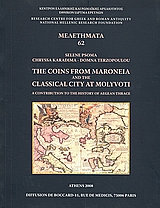
The Coins from Maroneia and the Classical City at Molyvoti
A Contribution to the History of Aegean Thrace Τύπος: ΒιβλίοΣυγγραφέας: Τερζοπούλου, Δόμνα / Καραδήμα, Χρύσα / Ψωμά, Σελήνη / Συλλογικό έργο,
Εκδόσεις: Εθνικό Ίδρυμα Ερευνών (Ε.Ι.Ε.). Ινστιτούτο Ελληνικής και Ρωμαϊκής Αρχαιότητας
- Χρονολογία Έκδοσης: 2008
- Σελίδες: 437
- ISBN-13: 978-960-7905-48-2
- Διαθεσιμότητα: **Αποστέλλεται κατόπιν παραγγελίας σε 2-4 ημέρες και εφόσον υπάρχει στον εκδότη
αρχική τιμή:
Compared with the showy and carefully selected silver and gold coins that typically represent Greek coinage inmost book illustrations and museum displays, coins recovered in archaeological excavations can be difficult to appreciate. By their very nature, excavation coins are unselected. Almost all are made of bronze, a metal that readily corrodes when buried in the ground. Apart from any damage by corrosion, many are heavily worn or broken. Because they were often lost and have been recovered in huge numbers, they can be extremely repetitive. And yet, while this might make them tedious from a museum or connoisseur's point of view, for the ancient historian the very quantity of such data is a rare blessing. Their abundance and the even more important criterion of provenience -the circumstance that every excavated coin was used at a particular site and so is tied in some way to the site's imperfectly known history- make these coins an invaluable documentary source for the history of the habitation in question.
Nevertheless, despite a century and a half of extensive archaeological activity in Greece, it is disappointing how few of the country's excavations have produced published numismatic reports. A recent survey of Greek coins found in archaeological excavations lists only nine ancient cities and sanctuaries in Greece for which there exists a published account of excavated coins. Moreover, all but one of these records pertain to excavations that were run by foreign archaeologists and published by foreign scholars. The shining exception was Zone, a little known urban site on the Aegean coast of Thrace that was excavated under the auspices of the Greek Archaeological Society and whose coins were summarily listed and reviewed in a 1996 article by Mina Galani-Krikou. A third of these 2.229 coins are the critically important coins of Zone that made possible the site's very identification.
In the present volume Selene Psoma of the Research Centre for Greek and Roman Antiquity (National Hellenic Research Foundation), Chryssa Karadima and Domna Terzopoulou of the XIX Ephorate of Prehistoric and Classical Antiquities (Ministry of Culture) now give us not only a welcome second publication of site coins excavated in Aegean Thrace but one in extended monograph form with commentaries and full attention to numismatic detail. Notably, the study treats the coins from two sites, one that has long been recognized as Maroneia, the other a previously unidentified city site on Cape Molyvoti. [...]
(from the preface)
| ISBN13: | 978-960-7905-48-2 |
| Συγγραφέας: | Συλλογικό έργο |
| Εκδότης: | Εθνικό Ίδρυμα Ερευνών (Ε.Ι.Ε.). Ινστιτούτο Ελληνικής και Ρωμαϊκής Αρχαιότητας |
| Χρονολογία Έκδοσης: | 2008 |
| Σελίδες: | 437 |
| Εξώφυλλο: | Μαλακό εξώφυλλο |
| Σχήμα: | 28χ21 |
| Διαθεσιμότητα: | Κυκλοφορεί |
| Βάρος: | 1636 γραμμάρια |
| Είδος: | Βιβλίο |
| Σειρά: | Μελετήματα |






















